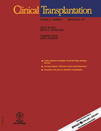Cost-effectiveness of screening for recurrent hepatocellular carcinoma after liver transplantation
Abstract
Ladabaum U, Cheng SL, Yao FY, Roberts JP. Cost-effectiveness of screening for recurrent hepatocellular carcinoma after liver transplantation.Clin Transplant 2011: 25: 283–291. © 2010 John Wiley & Sons A/S.
Abstract: The effectiveness of screening and treatment of recurrent hepatocellular carcinoma (HCC) after liver transplantation (LT) remains undefined. Our aim was to evaluate the potential cost-effectiveness of screening for recurrent HCC after LT. We constructed a Markov model of the natural history after LT for HCC. We superimposed screening with computed tomography, alpha-fetoprotein, and chest X-ray every six months for 1–5 yr after LT, with resection for treatable recurrence. Screening only those whose explant pathology exceeded Milan Criteria (MC) for two yr cost $138 000/life-yr gained, and the incremental cost of screening all patients was $340 000/life-yr gained. Screening for longer than two yr incurred progressively higher incremental costs/life-yr gained. The most critical variable in sensitivity analyses was the survival benefit of finding a resectable recurrence. With the most favorable assumptions for a two-yr screening duration, screening those whose explant pathology exceeded MC cost $91 000/life-yr gained. In conclusion, screening for HCC recurrence after LT would probably yield most of its benefit in the first two yr, but at a relatively high cost/life-yr gained. Screening for two yr in only those whose explant pathology exceeds MC may be relatively cost-effective depending on the survival benefit of resection.




